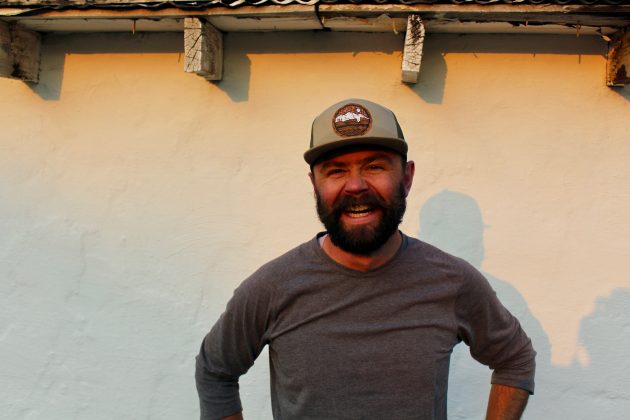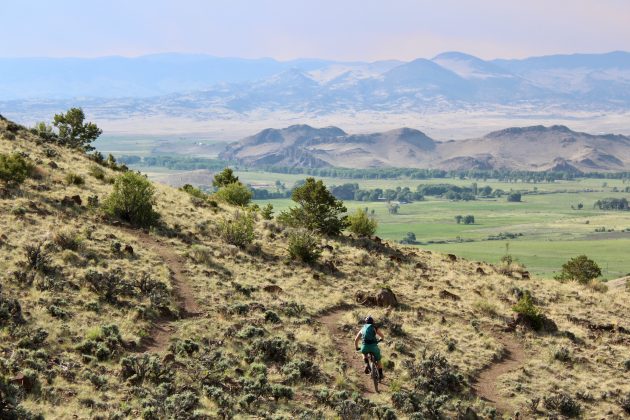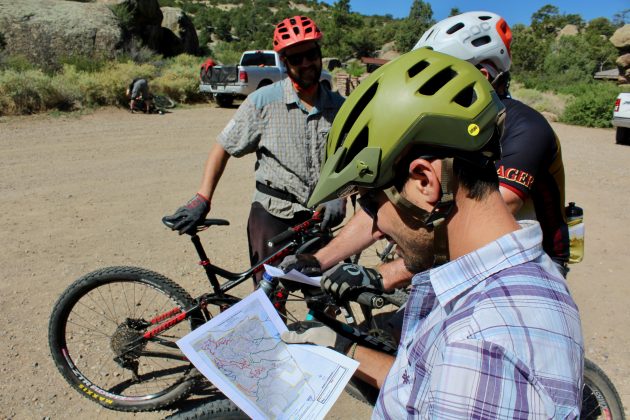Small town vibes, top notch rides: Del Norte is Colorado’s semi-secret gem
Originally posted on July 27, 2018 at 0:01 amBy Emma Walker

If you’re coming from the Front Range, Del Norte is on the way to big-name destinations—Wolf Creek, Pagosa Springs, Durango—but blink, and you might miss it. It was hard to believe, as I circled my truck around the block to pull in at the historic Windsor Hotel, that this was the place I’d been hearing so much about.
That’s how the locals like it. More than one resident compared Del Norte to Fruita or Durango twenty years ago, when there were great trails but the crowds riding them weren’t so big. Visit modern-day Del Norte, and you’ll find a town that’s trying to strike a balance: enough bike enthusiasts to ride their sustainable, newly-built trails, but not enough people to ruin the vibe.
So far, it’s working. The Del Norte Trails Showcase celebrated its fourth year in 2018; this time, unlike in years past, the Windsor’s quaint lobby was packed to the gills with something like 50 people from all over the state who’d shown up for the first day’s group ride.

It took a few minutes for the organizers to figure out what to do with all these mountain bikers, but soon enough, ringleader Brink Messick was welcoming riders to town. Messick works for the Colorado Mountain Club, but his role in developing valley-area trails goes well beyond his duties for the CMC. Talk to anyone in Del Norte—or look up the trails on your preferred mountain bike trail app—and you’ll hear that much of the credit for the area’s trail quality goes to Messick.
On the first day of the Trails Showcase, everyone headed to the Stone Quarry trails, a ten-minute drive east of town. Construction on bike-specific trails began at Stone Quarry in 2014, and progress has been made in one- or two-mile increments every year since, thanks in large part to cooperation from the Bureau of Land Management (BLM).
“It really is a community effort with the local land managers,” Messick explains. Stone Quarry was a citizen-proposed trail, but the BLM was integral in making it happen, both in helping write grants and in terms of the actual construction. The Del Norte Trails Organization, whose heart and soul are locals Marty and Bonnie Asplin, has been a key player in advocating for and developing the local systems.

“They’ve kept the flame alive, so to speak,” says longtime valley resident Mick Daniel, Executive Director of San Luis Valley Great Outdoors (SLVGO), which works to create opportunities for locals to get outside. The burgeoning mountain bike scene and its impact on the community in Del Norte is a prime example for SLVGO to work from.
The Del Norte community’s positive relationship with federal land management agencies isn’t unique to the Stone Quarry system. Nearby Bishop Rocks is a shining example of a well-run trail system, except that its only true “trail” is the one from the parking area to the open play area. “BLM helped construct a trail up to it,” Messick says of the natural bike park, where riders of all levels can test their skills, “but other than that, it’s up to riders to interpret it how they want to.”
A few hours after the group rides took off, riders started trickling back to the party on Columbia Avenue, adjacent to the Windsor. The block party wasn’t just visitors—the street was full of families and San Luis Valley locals, and it felt like walking into a potluck where everyone knows their neighbors well enough to look forward to the dishes they’re bringing.
Despite smoky air from the nearby Durango fires and the evening’s free-until-kicked beer kegs by Three Barrel, the Windsor lobby was packed again the next morning. This time, group rides headed to Pronghorn and Penitente for mild and spicy rides, respectively.
That Pronghorn exists for a group ride is a testament to the community’s commitment to make Del Norte mountain biking work. It was citizen-proposed, but that proposal generated a fair amount of conflict, since it’s also a crucial wildlife habitat and longtime hunting ground. This meant some compromises: parts of the original proposal were scrapped altogether, and there’s a seasonal closure that lasts for four months, from January 1 to April 30.

The result is some of the best intermediate riding you’ll find in Colorado. A nine-mile loop on Pronghorn mixes challenging climbing, moderately technical rock elements, a few rowdy descents, and sweeping valley views—and it’s accessible via a five-minute ride from downtown.
Penitente requires a slightly longer commute from downtown (it’s a twenty-minute drive to parking at the canyon). It’s known for its sport climbing, but the bike trails are smart and thoughtfully planned, and it’s easy to see why it’s Messick’s pet project.
“It’s the classic story of user-created trails being developed of a system,” he says, “But the original users were covered wagons.” It’s true: the soft rock, reminiscent of Moab-area slickrock—though it’s actually bedrock, not sandstone, he’s careful to mention—is worn in with double-track created by pioneers.
Messick took a group of riders to check out what’s next for Penitente trails. “They’re purpose-built trails,” he says. He’s walked every line to figure out how to make the Penitente system more sustainable, often using natural features for drainage and appropriate grading. “The terrain really lends itself to that.”

The building of new trails and influx of mountain bikers also made it possible for Alamosa-based Kristi Mountain Sports to open a new shop in Del Norte a few years ago.
“We have days where we’ll hand out 50 free maps of the area,” says Kristi owner Eric Burt, whose family has run the retailer since 1983 (and sold mountain bikes since 1986). In addition to the flurry of mountain bikers looking for trail maps, Kristi’s Del Norte location is a prime stop on the Great Divide Mountain Bike Route. Tour Divide riders regularly stock up on dehydrated meals and crash at the Divide Riders Hostel in Del Norte, but now, there’s someone to repair bikes and supply new parts, too.
The Windsor is a full house during the Tour Divide, too, says co-owner (and Chamber of Commerce Vice-President) Kevin Haas, a classic small-town wearer of many hats who also helps organize the annual Trails Showcase. “We’ll get a dozen, two dozen riders here,” he says, “That’s a lot for us.”
There’s no question bikes have been big for Del Norte, but when things quiet down, the town takes a breath. I heard it time and again from the locals, but Haas said it best.
“We all live down here for a reason.”
We can’t all live in Del Norte, but it’s well worth a visit. There’s enough riding—and varied riding, from high-alpine Middle Frisco to uber-desert Pronghorn, and from adventurous-beginner-friendly to super-gnarly—to keep your crew entertained for a long weekend. The best part? You really can go on a holiday weekend. You’ll still have the trails mostly to yourself.
IF YOU GO
When to go: The trails are rideable mostly year-round, although Pronghorn remains closed January through April, and locals are serious about obeying the closure. The monsoon season in the valley is in July and August, but even then, it doesn’t rain every day. And if it does, Messick says, you’re probably still in good shape: “If it rains in the morning, you’ve got hero dirt after lunch.”
Where to stay: There’s camping at Penitente. It’s not free anymore, but still cheap at $11/night. The Divide Riders Hostel is an affordable $30/night (cash only)—reservations aren’t required, and you can either check in at the adjacent Organic Peddlers, when it’s open, or call (719) 588-1892. Or treat yourself with a stay at the historic Windsor, which also has the nicest restaurant in town.
Where to eat: Three Barrel Brewing Company has great beers (not just for a small town—it’s good stuff) and, if it’s any indication, usually a full bike rack. They also serve excellent pizza. The Mystic Biscuit, just west of downtown proper, serves breakfast and phenomenal green chili. Starving after a ride? Head to Chavolos Mexican Restaurant for lots of authentic Mexican and a surprisingly small tab.